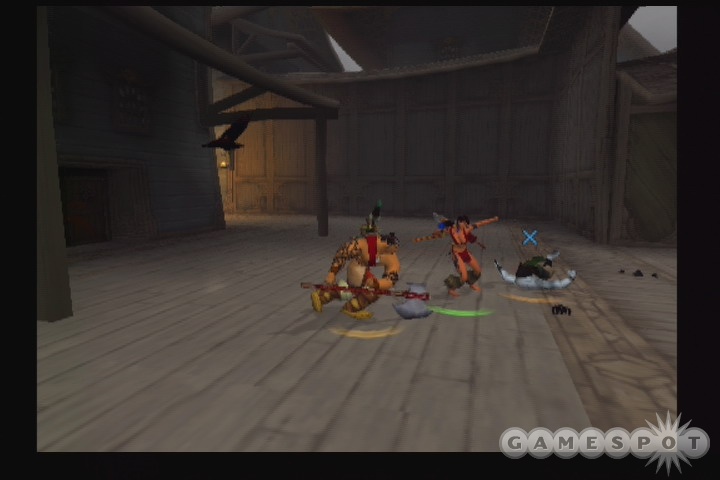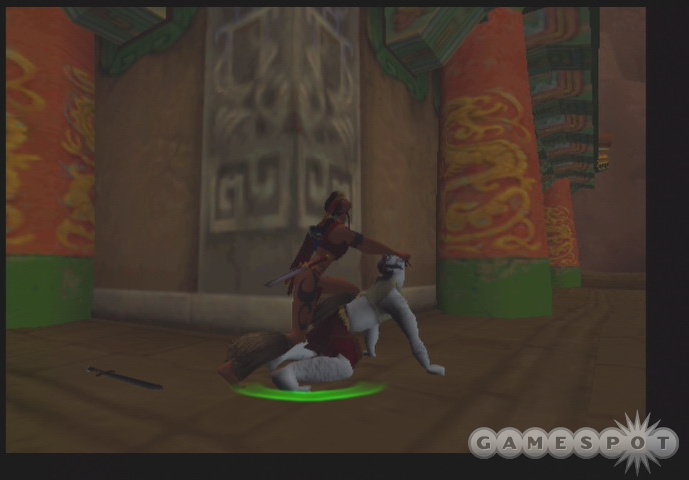2002's The Mark of Kri was an interesting dilemma. Despite being one of the most artistically inspired action games for its time, thanks largely to the efforts of some former animation-industry artists who had signed on to what was then Sony's internal San Diego studio (it's now the separate entity, Bottlerocket Entertainment), the underlying gameplay design wasn't quite there. By no means was Mark of Kri a bad game, but it didn't live up to the strengths of its concepts. Nearly three years later, Bottlerocket is releasing Rise of the Kasai, a sequel featuring the continuing adventures of Kri's hero, Rau, as well as a trio of other playable characters whose storylines intertwine over multiple time periods. Like its predecessor, Rise of the Kasai introduces interesting concepts, but it fails to deliver on them in an engaging way. Add to this a series of irritating bugs and rough edges, and what you end up with is simply a disappointment, all around.

Rise of the Kasai furthers the story of Rau, the barbaric warrior who was the centerpiece of Mark of Kri. Only now, Rau is not alone, as the story also revolves around Rau's younger sister, Tati, who has grown up considerably since the last game. The game also lets you play as another pair of warriors named Griz and Baumusu (the latter of which Kri fans will remember as Rau's mentor in the last game). All four characters tie in to a sweeping storyline that takes place over a period of 20 years. The basic plot revolves around the infamous Mark of Kri, a sinister tattoo that a handful of innocents were born with. It harbors evil powers, and Tati happens to bear one. The Kasai, an insidious cult that seeks to use the powers of Kri for clearly evil purposes, take on the role of the villains throughout the story, and it's up to you to protect Tati from the Kasai, as well as from the evil powers growing inside her.
At first, Rise of the Kasai's storyline can be immensely difficult to follow, simply because it refuses to follow any kind of linear path. You begin the game as Griz and Baumusu 10 years before the events of the first game, then you flash forward 10 years after the first game, to Rau and Tati's adventures. The whole story jumps around like this, and it's told through the dual narration of a mysterious oracle and Rau's trusty spirit guide, a raven named Kuzo. Though the narrators are vocally interesting and do a good job of delivering the dramatic dialogue that has been written for them, the script itself is a tough one to follow--at least at first. The narrative style has no interest in going out of its way to explain itself to you, so it's up to you to closely follow along with what point in time you're in, who or what the current threat is, and where it all fits in the grand scheme of things. In the end, it all comes together to a satisfactory conclusion, and even previously confusing sections of the story start to make sense, but as you're playing, you may find yourself a tad irritated with the game's opaque method of storytelling.
Since the character groups are broken up into pairs, you'll begin each level by choosing which character you want to play as. No matter whom you choose, your comrade will be right there alongside you, although only for specific portions of a level. Essentially, each character has a specific path to take during a stage. Though most of the time these paths are only marginally different, occasionally you will have to take on a different task during the same mission, such as with one boss fight against a massive dragon. If you're playing as Rau, you'll be fighting the dragon itself, but if you're Tati, you'll be fighting off hordes of Kasai bad guys, trying to keep them off Rau's back. This cooperative mechanic is conceptually a neat idea, and when it works, it works as well as it can within Kasai's gameplay structure. However, there are times when the whole thing will break down. Sometimes your partner will simply get hung up in a certain spot and refuse to move, no matter what you do. Most times you can simply ignore this and move on, but we did run into one spot where we seemingly couldn't do anything to progress so long as our partner was stuck, and we had to restart the section. Though issues that bad amounted to only one isolated incident, you're bound to run into at least a few of the smaller partner AI issues.

The AI issues don't end with your partner either, as the enemies in the game are frequently just as bad. Though they'll typically appear in large groups, it's entirely too easy to railroad even the oversized, overpowered guys by mashing the attack buttons. They'll throw up a fairly ineffective block and fail to get enough attacks in to stop you. Meanwhile, their buddies are evidently content to just circle around you, occasionally running in for an attack but ultimately not getting much done. There are even instances when one guy will simply stand still, not even acknowledging your presence--that is, until you've cut his head off and moved on. What makes this so annoying is that the game itself wants you to play as if the enemies actually pose a serious threat. There are multiple sections where you're expected to be stealthy and sneak up on an unwitting foe, dispatching him with one of a few ultraviolent and fairly cool stealth moves. While killing guys this way is certainly quicker than having to fight through a gang of bad guys, there's almost no consequence for hacking and slashing the whole way through, even though the game seems content to pretend that there is.
When you do find yourself engaged with the Kasai, odds are that anyone who played Mark of Kri will feel right at home with the combat system, as it's essentially the same system as before. You still use the right analog stick to "paint" your target, which causes a button icon to appear above the painted enemy. By pressing the corresponding button, your character will attack that foe. There are a number of attack combos you can use once you've engaged the enemy, but they require some fairly precise button presses--if you don't hit the buttons properly, your character will stop short after a couple of hits. While it doesn't take much time to learn the unique combos, and you won't get to see any crazy kill moves without performing a combo (none of which are that exciting, mind you), the game seems to reward you just as much for simply mashing on one attack button over and over. The enemy has a square icon over his head? OK, just hit the square button until he's dead.

The other problem with the combat is that there isn't a lot of variety between characters. Each character has an array of weapons, but aside from the blatantly different ones, such as Rau's bow and arrow, there's almost no difference between them in combat. For instance, when Rau attacks someone with a spear versus with an axe, the only difference is a bit of speed. Tati is smaller and more agile, but again, no matter what weapon she's using, it always feels pretty much the same. Were there a little more depth and variety to the combat, you might be able to deal with how dull the enemy AI is, but when you combine the two, you end up with a pretty dull experience.
One area where Rise of the Kasai most definitely does not fall short is its presentation--at least, aesthetically. The animation-industry backgrounds of the game's developers really shine through, especially with the cutscenes. In between levels and during story bits, everything is told through a series of uniquely designed hand-animated sequences, all of which are extremely inventive. You'll notice the same attention to detail in the animation of the characters in-game, as they leap and jump and swing their weapons like crazy, and enemies find themselves beheaded, split in half, or generally stabbed to death. The way the characters move is great, and the designs of the principal characters really capture the sort of Disney-meets-Conan the Barbarian concept the game is aiming for. Now, with that said, as much as the game manages to nail aesthetics, on the technical side, the game has trouble keeping up. Texture seams, camera glitches (such as when the camera decides to actually go under the floor), and periodically broken combat sequences, where you'll see your character finish off a bad guy by driving his sword into what looks like his leg, rather than a more fatal area, are prevalent through much of the game. While the aesthetic values of the game's visuals are still pleasing, despite these problems, the lack of overall polish is a hindrance.

The audio in Rise of the Kasai is mostly quite enjoyable. The narrators make up nearly all the dialogue in the game, and between the two of them, they capture the proper atmosphere nicely. The dialogue itself can be a bit hard to take in, as mentioned before, mainly because the writing is filled to the brim with references to assorted names and locations that are difficult enough to pronounce, let alone remember, but all told, the narrators get the proper points across and do a fine job of telling the story. The soundtrack is made up of some well-produced tribal-sounding drums and flutes and such, all of which fit perfectly into the context of the game. All the in-game effects are similarly great, from the gushing sounds of blood, to the scrapes of metal against armor. There are a few annoying effects here and there, such as the ridiculously overstated enemy death throes--that much shrieking and gurgling we definitely could have done without--but they don't really detract too much.
In the end, whereas Mark of Kri managed to overcome its rough areas, thanks largely to its innovative concepts, Rise of the Kasai lacks this benefit, simply because those innovations aren't innovative anymore. The one new concept it brings to the table, namely the cooperative play mechanic, isn't nearly as interesting as it could have been, and what remain are mechanics that didn't feel quite right over two years ago, let alone today. On top of that, the list of nagging bugs, as well as the fact that the game itself is fairly short, ultimately relegates Rise of the Kasai to rental status at best for fans of the original. And if you weren't a big fan of Mark of Kri, you're not missing anything here.